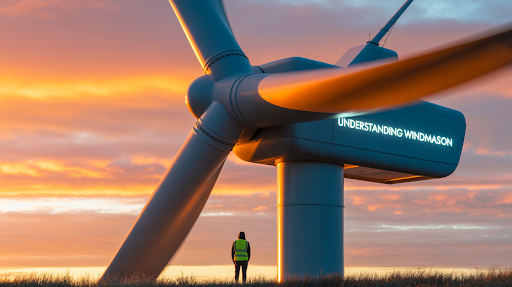Imagine a craftsman of the winds — not in poetry, but in science and engineering. That’s essentially what a Windmason is. Whether you see it as a futuristic profession, a cutting-edge company, or a revolutionary idea, the term “Windmason” suggests mastery over the movement, use, and control of wind for practical and sustainable purposes.
So, what is Windmason really? Let’s dive deep into this intriguing concept that blends renewable energy, architectural finesse, environmental sustainability, and smart technology into one dynamic package.
The Evolution of Wind Technology
From Ancient Times to Now
Wind has always fascinated humankind. From ancient windmills grinding grain in Persia to the tall, sleek wind turbines scattered across modern landscapes, we’ve come a long way. Our ancestors harnessed wind for basic utilities, but today’s technology lets us convert breezes into power that lights up homes and powers cities.
Modern Wind Turbines
Today’s wind turbines are feats of engineering. Towering hundreds of feet into the sky, they spin with elegance and precision, generating electricity on a massive scale. They’re smart, efficient, and a symbol of the green energy revolution.
A Leap Toward Smart Wind Systems
But what happens when we add artificial intelligence, predictive analytics, and design thinking into the mix? We get Windmason — a next-gen approach to wind utilization.
Windmason: A Concept or a Brand?
Is Windmason a job title? A company name? Or just a concept? That’s the mystery and the magic of it.
It might be:
- A specialized role in wind engineering
- A forward-thinking company leading innovations
- A philosophy around sustainable wind usage
Regardless of what the label truly represents, Windmason is about mastering wind in practical, beautiful, and sustainable ways.
Windmason in Renewable Energy
Pushing Boundaries in Green Tech
Windmason doesn’t just ride the wave of renewable energy — it pushes it forward. Think of integrating real-time data to direct wind turbines to optimal angles, or designing blades that change shape based on wind strength.
Game-Changing Innovations
- Self-adjusting turbines
- Urban wind harvesting systems
- Micro-wind grids for neighborhoods
These aren’t ideas from science fiction. They’re innovations Windmason-style engineers are working on now.
Smart Wind Solutions
AI Meets Wind
Artificial intelligence in wind energy helps with:
- Forecasting wind patterns
- Scheduling maintenance
- Maximizing energy output
This smart tech allows for minimal downtime and maximum efficiency — saving both time and money.
Turbines That Learn
Imagine a wind turbine that learns from weather patterns and adjusts its behavior. Windmason thinking makes that possible. It’s the Fitbit of the energy world, tracking data and adjusting in real time.
Windmason and Architecture
Building with the Wind, Not Against It
Windmason principles shape how we build. Instead of resisting wind, buildings are now designed to:
- Redirect airflow
- Reduce pressure zones
- Harness wind for ventilation or power
Urban Planning Reinvented
Cities can be designed to:
- Naturally cool themselves
- Avoid wind tunnels
- Create comfortable pedestrian zones
Windmason in Engineering Education
Academic Evolution
As the demand for sustainable and intelligent design grows, so does interest in Windmason-related studies. Universities are:
- Introducing wind optimization courses
- Offering smart energy systems degrees
- Hosting wind-focused research centers
The Science Behind Wind Manipulation
Mastering Aerodynamics
Windmason engineers study how air moves, how it interacts with surfaces, and how to control it. It’s part physics, part art.
Microclimates and Modeling
Windmason practices involve creating virtual wind environments before real-world construction — saving money and maximizing efficiency.
Tools and Technologies Used by a Windmason
- Wind tunnels for physical testing
- CFD simulations for digital analysis
- LIDAR sensors for real-time wind speed and direction
These tools help Windmasons see the invisible — the flow and force of air in all its complexity.
Real-World Applications
Powering the Future
From massive wind farms in the ocean to urban wind turbines on rooftops, Windmason technology is powering the future.
Smarter Cities
- Building facades that move with the wind
- Turbines built into skyscrapers
- Wind-powered streetlights
Case Studies of Windmason Practices
- The Bahrain World Trade Center – turbines integrated into the design
- Masdar City, UAE – a city planned around airflow
- The Edge in Amsterdam – uses airflow for interior climate control
Challenges Faced by Windmasons
Balancing Design and Performance
It’s not always easy to make something beautiful and functional — but that’s what Windmason experts strive for.
Environmental & Regulatory Hurdles
- Permits for wind installations
- Noise and wildlife concerns
- Land usage limitations
Future of Windmason
As cities get smarter and the planet demands cleaner energy, Windmason principles will:
- Guide new city designs
- Power remote communities
- Influence everyday appliances (yes, even your ceiling fan!)
Windmason vs Traditional Wind Engineering
| Feature | Traditional Engineer | Windmason |
| Focus | Function | Function + Form + Future |
| Tools Used | Mechanical | Mechanical + Digital + AI |
| Approach | Static | Dynamic & Predictive |
| Energy Application | Utility-scale only | Utility + Urban + Micro |
Conclusion
Whether it’s a title, a brand, or a movement — Windmason is about shaping the future with wind. It’s about seeing opportunity in the air, literally. By combining creativity, sustainability, and technology, Windmason thinking can help solve some of our planet’s biggest problems — from clean energy to smarter living spaces.
FAQs
1. What qualifications do you need to become a Windmason?
A background in engineering, environmental science, or architecture with a focus on wind systems or renewable energy is key. Specialized courses in fluid dynamics or sustainable design are a bonus.
2. Is Windmason a recognized career?
While not officially titled “Windmason,” careers in wind engineering, smart city planning, and renewable design all fall under the umbrella.
3. How does Windmason differ from aerodynamics?
Aerodynamics is a science. Windmason is an applied philosophy — taking that science and using it to design, build, and power the future.
4. Can Windmason improve city living?
Absolutely. Better wind flow in cities can reduce pollution, lower temperatures, and even power streetlights and buildings.
5. What’s the future potential for Windmason in climate change?
Huge. As we move toward net-zero carbon goals, Windmason techniques could help cities, companies, and homes rely more on wind for energy and comfort.





























